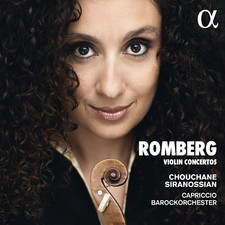 Andreas Romberg: Violinkonzerte Nr. 4, 9, 12; Chouchane Siranossian, Capriccio Barockorchester; 1 CD Alpha 452; Aufnahme 04/2018, Veröffentlichung 22/01/2021 (76'50) - Rezension von Remy Franck
Andreas Romberg: Violinkonzerte Nr. 4, 9, 12; Chouchane Siranossian, Capriccio Barockorchester; 1 CD Alpha 452; Aufnahme 04/2018, Veröffentlichung 22/01/2021 (76'50) - Rezension von Remy Franck

Wer bei Google ‘Romberg’ eingibt, kommt zunächst einmal zu einer Firma Romberg, die so für sich wirbt: « Die Marke Romberg verbindet all die Werte, für die das Romberg-Sortiment steht: Lebendigkeit, pralles Leben, Üppigkeit und garantierten Anzuchterfolg! » Eigentlich passt das sehr gut zu dieser Aufnahme. Lebendiger, praller und üppiger kann man sich die Violinkonzerte von Andreas Romberg nicht vorstellen. Und von wegen Anzuchterfolg: Chouchane Siranossian hat die drei Stecklinge zu großartigen Pflanzen hochgezogen, getreu dem Motto der oben genannten Firma: « Romberg: Mach was draus ». Und genau das passiert hier. Andreas Romberg hatte zu Lebzeiten weder als Komponist noch als Geiger dauerhaften Erfolg. Der als eher als kühl und rational bekannte Norddeutsche schrieb eine Musik, die technisch ausgefeilt war und Substanz hatte: pure Virtuosität und Schaustücke waren nicht so sehr seine Sache. Den Interpreten obliegt es, eben, was draus zu machen. Mit einem bloß gepflegten Spiel ist den Werken nicht gedient.
Chouchane Siranossian bringt so viel Gestaltungsphantasie in die drei Konzerte ein, so viel Spontanität, so viel Sinn für Farben und Akzente, dass man sich nur daran erfreuen kann. Kirschrot, himbeerfarben, limonengelb, azurblau, es gibt in diesem Spiel der Geigerin keine leuchtende Farbe, die die Natur nicht hat, von puderrosa bis saftgrün. Der Blumenstrauß wird gesteckt mit kleinen und großen Blumen und Blättern, mit delikaten Verzierungen, bezaubernd anmutig und frisch, und er wird uns zugeworfen mit federnder Leichtigkeit. Und vollends zur Wirkung kommt er dann vor dem Hintergrund des nicht weniger exzellenten Orchesters, dessen Musiker Eleganz und Raffinement mit Intensität und kraftvollen Akzenten verbinden, im vollkommenen Ausgleich von Virtuosität und Musikalität, von Kraft und Leichtigkeit. Im Vergleich etwa schneidet die Aufnahme des 3. Konzerts mit Yury Revich (Pizzicato-Rezension) wegen des etwas hölzernen Klangs des Orchesters bei weitem nicht so gut ab.
Dass die drei Konzerte der vorliegenden, auf Basis der in Hamburg aufbewahrten Manuskripte gemachten Aufnahmen so deutlich aufgewertet werden, ist gewiss auf diese kongeniale Zusammenarbeit eines hervorragenden Orchesters mit einer wegen ihrer intelligent-phantasievollen Gestaltungskraft geradezu genialen Geigerin zurückzuführen. Mithin sind diese Ersteinspielungen ein wichtiger Beitrag und eine eminente Rehabilitierung von Andreas Romberg.
If you type ‘Romberg’ into Google, the first link that comes up is the one of a garden center called Romberg that advertises like this: « The Romberg brand combines all the values that Romberg stands for: vibrancy, strong life, lushness and guaranteed growing success! » Actually, that fits this recording very well. Andreas Romberg’s violin concertos could hardly be more vivid, plump and luxurious. And to speak about the ‘growing success’: Chouchane Siranossian has raised the three seedlings to great plants, true to the motto of the above-mentioned company: « Romberg: Make something of it ». And that is exactly what is happening here. Andreas Romberg had no lasting success during his lifetime, either as a composer or as a violinist. Known as rather cool and rational, the North German wrote music that was technically sophisticated and had substance: pure virtuosity and showpieces were not so much his thing. It is up to the interpreters to make something of it. The works are not served by mere cultivated playing.
Chouchane Siranossian brings so much creative imagination to the three concertos, so much spontaneity, and so much sense for colors and accents that one can only enjoy them. Cherry-red, raspberry, lime-yellow, azure-blue, there is no bright color in this violinist’s playing that nature does not have, from powder-pink to sap-green. The bouquet is set with small and large flowers and leaves, with delicate ornaments, enchantingly graceful and fresh, and thrown at us with light elegance. And it comes to full effect against the background of the no less excellent orchestra, whose musicians combine elegance and refinement with intensity and powerful accents, in a perfect balance of virtuosity and musicality, of power and lightness. In comparison, for example, the recording of the 3rd concerto with Yury Revich (Pizzicato review) does not fare nearly as well because of the somewhat wooden sound of the orchestra.
The fact that the recording of the three concertos, made on the basis of the manuscripts preserved in Hamburg, are so clearly enhanced is certainly due to this congenial collaboration of an outstanding orchestra with a violinist who is downright brilliant because of her intelligent and imaginative creative power. These premiere recordings are therefore an important contribution and an eminent rehabilitation of Andreas Romberg.


















